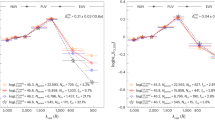Abstract
It has become part of the conventional wisdom of quasar research that quasars cannot be objects ejected from nearby galaxies. The reasons are summarized in Burbidge & Burbidge (1967) and they include: (1) in quasar spectra only redshifts, and no blueshifts, are observed, contrary to expectation in a local Doppler interpretation of quasar line shifts; (2) the energy requirements for relativistically moving quasars seem excessive and the ejection mechanism is unknown. In. this work we show that the first problem could be explained via some powerful selection effects, and that the second problem does not exist in the relativistic slingshot process of ejecting black holes. Consequently one cannot exclude the possibility that at least some of the quasar-galaxy associations of large redshift differentials discussed by Arp and Sulentic are real and that the redshift differences are due to high speeds of ejected quasars
Similar content being viewed by others
References
Aitken, D. K., Roche, P. F. 1985,Mon. Not. R. astr. Soc.,213, 777.
Arp, H. 1973, inThe Redshift Controversy, Eds G. B. Field, H. Arp & J. N. Bahcall, W. A. Benjamin, Reading, p. 15.
Arp, H. 1981,Astrophys. J.,250, 31.
Arp, H. 1990,Astr. Astrophys.,229, 93.
Arp, H., Burbidge, G. 1990,Astrophys. J.,353, L1.
Arp, H., Hazard, C. 1980,Astrophys. J.,240, 726.
Arp, H., Sulentic, J. W. 1979,Astrophys. J.,229, 496.
Arp, H., Sulentic, J. W., di Tullio, G. 1979,Astrophys. J.,229, 489.
Bassani, L., Dean, A. J., Sembay, S. 1983,Astr. Astrophys.,125, 52.
Basu, D. 1973,Nature Phys. Sci,241, 159.
Basu, D. 1975,Astrophys. Lett.,16, 53.
Basu, D. 1987,Astr. Nachr.,308, 299.
Biretta, J. A., Moore, R. L., Cohen, M. H. 1986,Astrophys. J.,308, 93.
Burbidge, E. M., Burbidge, G. R. 1967, inQuasi-Stellar Objects, Freeman, San Francisco, p. 171.
Burbidge, E. M., Junkkarinen, V. T., Koski, A. T., Smith, H. E. 1980,Astrophys. J.,242, L55.
Carr, B. J. 1978,Comm. Ap. 7, 161.
Carr, B. J., Bond, J. R., Arnett, W. D. 1984,Astrophys. J.,277, 445.
Carroll, T. J., Kwan, J. 1985,Astrophys. J.,288, 73.
Cutri, R. M., Rieke, G. H., Lebofsky, M. J. 1984,Astrophys. J.,287, 566.
De Diego, J. A., Kidger, M. 1990,Astrophys. Sp. Sci.,171, 97.
De Young, D. S. 1977,Astrophys. J.,211, 329.
Elliot, J. L., Shapiro, S. L. 1974,Astrophys. J.,192, L3.
Fugmann, W. 1989,Astr. Astrophys.,222, 45.
Gabuzda, D. C., Wardle, J. F. C., Roberts, D. H. 1989,Astrophys. J.,336, L59.
Giovanelli, R., Haynes, M. 1989,Astrophys. J.,346, L5.
Grasdalen, G. L. 1976,Astrophys. J.,208, L11.
Gunn, J. E. 1971,Astrophys. J.,164, L1 13.
Heggie, D. C. 1975,Mon. Not. R. astr. Soc.,173, 729.
Hewitt, A., Burbidge, G. 1987,Astrophys. J. Suppl.,63, 1.
Impey, C., Bothun, G., Malin, D., Staveley-Smith, L. 1990,Astrophys. J.,351, L33.
Krolik, J. H., Vrtilek, J. M. 1984,Astrophys. J.,279, 521.
Le Van, P. D., Puetter, R. C., Smith, H. E., Rudy, R. J. 1984,Astrophys. J.,284, 23.
Lin, D. N. C., Saslaw, W. C. 1977,Astrophys. J.,217, 958.
Mathews, W. G., Baker, J. C. 1971,Astrophys. J.,170, 241.
Mathews, W. G., Loewenstein, M. 1986,Astrophys. J.,306, L7.
Mikkola, S., Valtonen, M. J. 1990,Astrophys. J.,348, 412.
Narasimha, D., Narlikar, J. V. 1989,Astrophys. J.,338, 44.
Narlikar, J. V., Edmunds, M. G. 1981,J. Astrophys. Astr.,2, 289.
Narlikar, J. V., Subramanian, K. 1982,Astrophys. J.,260, 469.
Narlikar, J. V., Subramanian, K. 1983,Astrophys. J.,273, 44.
Osmer, P. S., Smith, M. G. 1980,Astrophys. J. Suppl.,42, 333.
Osterbrock, D. E., Mathews, W. G. 1986,A. Rev. Astr. Astrophys.,24, 171.
Peters, P. C. 1964,Phys. Rev.,136, B1224.
Puetter, R. C., Hubbard, E. N. 1985,Astrophys. J.,295, 394.
Rees, M. J. 1986, inIAU Symp. No. 119: Quasars, Eds G. Swarup & V. K. Kapahi, D. Reidel, Dordrecht, p. 1.
Rees, M. I., Saslaw, W. C. 1975,Mon. Not. R. astr. Soc.,171, 53.
Rieke, G. H., Lebofsky, M. J. 1979,A. Rev. Astr. Astrophys.,17, 477.
Roche, P. F., Aitken, D. K., Phillips, M. M., Whitmore, B. 1984,Mon. Not. R. astr. Soc.,207, 35.
Rudy, R. J. 1984,Astrophys. J.,284, 33.
Sandage, A. 1966,Astrophys. J.,146, 13.
Saslaw, W. C., Valtonen, M. J., Aarseth, S. J. 1974,Astrophys. J.,190, 253.
Schmidt, M. 1963,Nature,197, 1040.
Stickel, M., Fried, J. W., Kühr, H. 1989,Astr. Astrophys. Suppl.,80, 103.
Stockton, A. 1978,Nature,274, 342.
Stockton, A., Wyckoff, S., Wehinger, P. A. 1979,Astrophys. J.,231, 673.
Strittmatter, P., Burbidge, G. R. 1967,Astrophys. J.,147, 13.
Sulentic, J. W. 1983,Astrophys. J.,265, L49.
Sulentic, J. W., Arp, H. 1987a,Astrophys. J.,319, 687.
Sulentic, J. W., Arp, H. 1987b,Astrophys. J.,319, 693.
Tyson, J. A. 1986, inIAU Symp. No. 119: Quasars, Eds G. Swarup & V. K. Kapahi, D. Reidel, Dordrecht, p. 551.
Valtaoja, E., Lehto, H., Teerikorpi, P., Korhonen, T., Valtonen, M., Teräsranta, H., Salonen, E., Urpo, S., Tiuri, M., Piirola, V., Saslaw, W. C. 1985,Nature,314, 148.
Valtaoja, L., Valtonen, M. J., Byrd, G. G. 1989,Astrophys. J.,343, 47.
Valtonen, M. J. 1976,Astr, Astrophys.,46, 435.
Valtonen, M. J. 1988,Vistas Astr.,32, 23.
Yee, H. K. C., Green, R. F. 1984,Astrophys. J.,280, 79.
Wyckoff, S., Wehinger, P. A., Gehren, T. 1981,Astrophys. J.,247, 750.
Author information
Authors and Affiliations
Rights and permissions
About this article
Cite this article
Valtonen, M.J., Basu, D. Ejections of quasars at relativistic speeds from nearby galaxies: Ejection mechanism and selection effects. J Astrophys Astron 12, 91–110 (1991). https://doi.org/10.1007/BF02709299
Received:
Accepted:
Issue Date:
DOI: https://doi.org/10.1007/BF02709299




